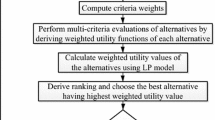Abstract
Supplier selection is a multi-criteria problem which includes both tangible and intangible factors. In these problems when suppliers have capacity or other different constraints, two questions persist: which suppliers are the best and how much should be purchased from a selected supplier? Here, we propose an integrated approach of analytic hierarchy process (AHP), Technique for Order Preference by Similarity to an Ideal Solution (TOPSIS), and multi-objective nonlinear programming to consider both tangible and intangible factors in choosing the best suppliers and define the optimum quantities among selected suppliers to maximize the total value of purchasing and minimize the budget, total penalized earliness and tardiness, and defect rate. The priorities are calculated for each supplier by use of AHP. TOPSIS is applied to rank the suppliers. Finally, using the obtained weights, the optimal quantities of order to the suppliers are clarified in multi-period horizon. An application study presents the validity and efficiency of the proposed model. Moreover, a performance analysis has been worked out on the numerical example to investigate the capability and effectiveness of the results.
Similar content being viewed by others
References
Cho G, Kim J, Ho Park H, Noh C-S, So S-H, Park YS, Jung KH (2008) An Optimal Decision Making Model for Supplier and Buyer’s Win-Win Strategy in a Two Echelon Supply Chain. In: Proceedings Of the 41st Hawaii International Conference on System Sciences, 7–10 January 2008, Waikoloa, Big Island, HI, USA. p 1–12
Stueland VJ (2004) Supplier evaluations: best practices and creating or improving your own evaluation, Wells Fargo Services Company. In: Proceedings of 89th Annual International Supply Management Conference, April 2004. pp 175–191
Ghodsypour SH, O’Brien C (1998) A decision support system for supplier selection using an integrated analytic hierarchy process and linear programming. Int J Prod Econ 56–57:199–212
Mandal A, Deshmukh SG (1994) Vendor selection using interpretive structural modelling (ISM). Int J Oper Prod Manage 14(6):52–59
Sarkis J, Talluri S (2002) A model for strategic supplier selection. J Supply Chain Manag 38(1):18–32
Braglia M, Petroni A (2000) A quality assurance-oriented methodology for handling trade-offs in supplier selection. Int J Phys Distrib Logist Manag 30(2):96–111
Skjott-Larsen T, Kotzab H, Grieger M (2003) Electronic marketplaces and supply chain relationships. Ind Mark Manage 32(3):199–210
Akarte MM, Surendra NV, Ravi B, Rangaraj N (2001) Web based casting supplier evaluation using analytical hierarchy process. J Oper Res Soc 52(5):511–522
De Boer L, Van der Wegen L, Telgen J (1998) Outranking methods in support of supplier selection. Eur J Purch Supply Manag 4(2–3):109–118
Grando A, Sianesi A (1996) Supply management: A vendor rating assessment. CEMS Business Review 1:199–212
Sarkis J, Talluri S (2000) A model for strategic supplier selection. In: Leenders M (ed) Ninth International IPSERA Conference. London, Ontario, pp 652–661
Degraeve Z, Roodhooft F (2000) A mathematical programming approach for procurement using activity based costing. J Bus Finance Account 27(1–2):69–98
Drexl A, Kimms A (1997) Lot sizing and scheduling–survey and extensions. Eur J Oper Res 99(2):221–235
Suerie C, Stadtler H (2003) The capacitated lot-sizing problem with linked lot sizes. Manage Sci 49(8):1039–1054
Trigeiro WW, Thomas JL, McCain JO (1989) Capacitated Lot Sizing with Setups. Manage Sci 35:141–161
Nemhauser GL, Wolsey LA (1999) Integer and combinatorial optimization. Wiley, New York, 2
Berkowitz M (2000) A Primer on Developing an E-Business Strategy. First Stop Business Information Center, 620 E. Adams Springfield, IL 62703
Kumar S, Bisson J (2008) Utilizing analytic hierarchy process for improved decision making within supply chains. J Human Syst Manag 27(1):49–62
Dickson GW (1966) An analysis of vendor selection systems and decisions. J Purch 2(5):17–32
Keeney R, Raiffa H (1976) Decision with multiple objectives: Preference and value tradeoffs. Wiley, New York
Teng J-Y (2002) Project evaluation: Method and applications. Taiwan, National Taiwan Ocean University, Keelung
Saaty TL (1980) The Analytic, Hierarchy Process. McGraw-Hill, New York
Schniederjans MJ, Garvin T (1997) Using the analytic hierarchy process and multi-objective programming for the selection of cost drivers in activity based costing. Eur J Oper Res 100:72–80
Macharis C, Springael J, De Brucher K, Verbeke A (2004) PROMETHEE and AHP: The design of operational synergies in multicriteria analysis. Strengthening PROMETHEE with ideas of AHP. Eur J Oper Res 153(2):307–317
Hwang CL, Yoon K (1981) Multiple attributes decision making methods and applications. Springer, Berlin
Author information
Authors and Affiliations
Corresponding author
Rights and permissions
About this article
Cite this article
Fazlollahtabar, H., Mahdavi, I., Ashoori, M.T. et al. A multi-objective decision-making process of supplier selection and order allocation for multi-period scheduling in an electronic market. Int J Adv Manuf Technol 52, 1039–1052 (2011). https://doi.org/10.1007/s00170-010-2800-6
Received:
Accepted:
Published:
Issue Date:
DOI: https://doi.org/10.1007/s00170-010-2800-6




